Every handmade quilt is a work of art, full of intricate puzzle-piece fabric shapes stitched cunningly together into one large design. If you’re new to the world of quilting, you may find yourself wandering the aisles of your local sewing store, trying to select the right fabric. What is quilting fabric, and where can you find it?
The most popular type of quilting fabric is quilter’s weight cotton, which contains 100% cotton in a medium-weight plain weave. This dense form of cotton does not shrink much in the wash and can withstand years of use. Other popular quilting materials include flannel, wool, and linen.
In this article, you will find out what defines a good quilting fabric. You will also learn the key characteristics of the top seven quilting materials. Finally, you will discover quilting resources to help you get started sewing your quilt!
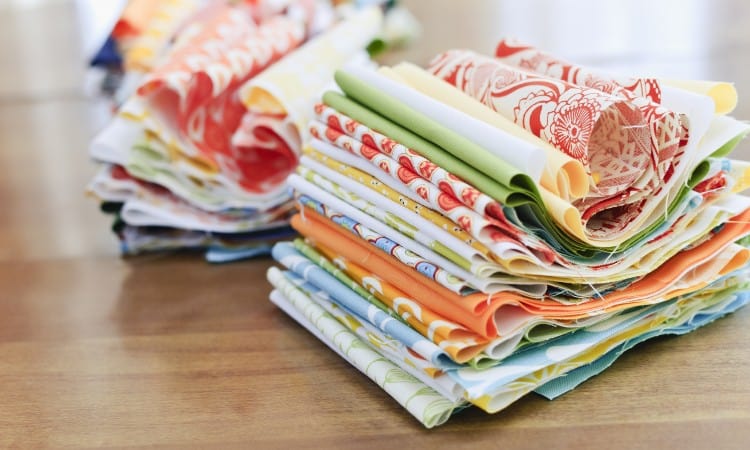
What is Quilting Fabric?
Quilting fabric could describe any material used to sew a quilt, but it usually refers to 100% medium-weight quilting cotton. This semi-stiff material typically features intricate prints in any design imaginable.
Most quilting materials use a plain weave, meaning a basic over-under basketweave pattern. The better-quality fabric has a denser weave. You don’t want to use a loose weave in your quilt because it will have much less strength and durability!
Good-quality quilting cotton has a high thread count to make it soft to the touch despite its heavier weave. This material is the most popular for quilting because it doesn’t stretch as much as a thinner fabric during sewing, and it holds up through many washes.
That said, you may prefer to use fuzzy cotton flannel, especially if you want to sew a baby quilt!
Or you can design a novelty quilt using old t-shirts to create a memorable keepsake.
Many different types of fabric can make beautiful quilts. Once you know what to look for in each type, you can choose which material best suits your needs!
Weight of Material
Quilter’s weight cotton is medium-weight quilting cotton that weighs more per square yard than apparel cotton. Quilting cotton weighs more because it has a dense weave, a high thread count, and a stiff texture.
For example, quilting cotton usually weighs at least 4 oz per square yard. Apparel cotton such as cotton lawn only weighs two to three oz per square yard.
Does using quilters weight material matter? Well, this denser, sturdier fabric gives you a lot of advantages during the quilting process, as you will see!
Parts of the Quilt
Understanding the basic parts of a quilt, such as quilt blocks, backing, and binding, will help you choose the best fabric.
When you design a quilt, you almost always build the design in squares, called quilt blocks. These blocks typically measure 10 inches square, 5 inches square, or 2.5 inches square, depending on the size of the finished quilt.
When you talk about quilting fabric, you usually mean the fabric used to create these quilt blocks. That said, you also need material for two other key portions of the quilt: the backing and the binding.
Quilt backing forms the bottom layer of the quilt sandwich. You will most often see a plain fabric used here, such as undyed white or cream. For a sturdy, long-lasting quilt, you may want to use quilting cotton for this layer.
That said, you can also use lighter-weight cotton for a more cost-effective backing. As a pro tip, creating the backing is easier if you purchase a wider fabric with a 60-inch or even 108-inch width instead of the 45” width of most quilting cotton.
Binding covers the raw edges of the quilt, giving it a neatly encased outer perimeter. You can buy premade fabric strips for this purpose or cut your own. If you have a quilt with a curved outer edge, you will need a bias-cut binding that will stretch to fit the curve.
Quilt binding often uses quilting cotton in a color that matches or complements the design in the quilt blocks. Alternatively, you can also use satin edging for a super-smooth finish!
Top 7 Best Types of Fabric for Quilting
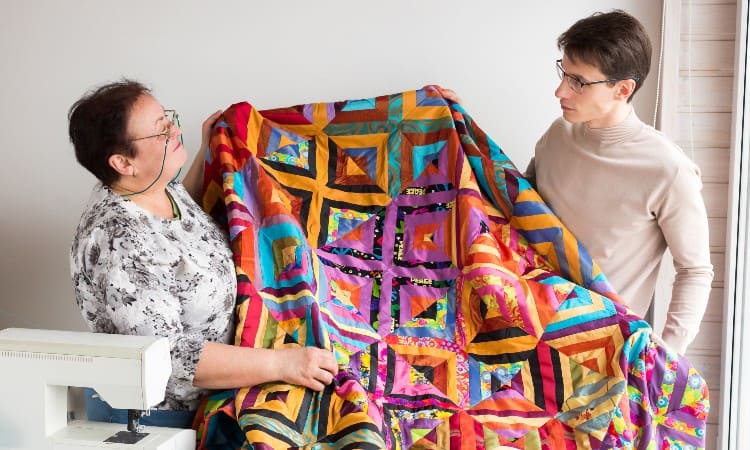
If you aren’t sure what fabric to choose for your next quilt, take a look at the seven most popular choices for quilting fabric. Each one has strengths and weaknesses, of course. Each type of material also creates a unique look and texture for your quilt.
No matter what material you choose, you should select just one type of fabric for the whole quilt. Mixing types of material together may look nice at first, but the different fabrics will stretch and shrink differently the first time you have to wash the quilt!
Plus, you should always use thread made of the same material as your fabric, and you don’t want to have to switch thread spools constantly as you sew from one material to another!
1. Quilter’s Weight Cotton
 By far the most popular choice for quilting, quilter’s weight cotton has a unique thickness and durability that makes it an excellent choice for a long-lasting quilt. It holds its shape well and does not stretch out easily during the sewing process. It also washes well and lasts a long time because of its extra weight and thickness.
By far the most popular choice for quilting, quilter’s weight cotton has a unique thickness and durability that makes it an excellent choice for a long-lasting quilt. It holds its shape well and does not stretch out easily during the sewing process. It also washes well and lasts a long time because of its extra weight and thickness.
The stiff edges of quilters cotton also don’t fray quite as quickly. This fabric cuts out easily and allows for precisely matching shapes to build your quilt blocks. Unlike lighter fabric that easily stretches or skews as you sew seams, quilters fabric will not stretch out easily if you pin or clip it neatly before you sew.
Now, not all quilter’s weight cotton is created equal. Premium brands sell cotton that has a higher thread count. For example, good-quality quilting cotton should have a thread count between 68-78 threads per square inch, while your average quilting cotton comes in at just 60.
Quilting cotton is not the same as apparel cotton. While you can use quilting cotton to make certain types of clothing, it usually feels too stiff to rest comfortably against your skin. Apparel cotton drapes easily because of its lighter weave and feels softer to the touch.Quilting cotton does wrinkle easily, but it also irons well. You can steam or iron wrinkles out in a jiffy as you put your quilt blocks together! You need to pre-wash any type of cotton before quilting, though, because even high-quality cotton shrinks in the wash.
2. 100% Quilting Cotton
 This is a bit of a trick category because 100% quilting cotton should be the same thing as quilter’s weight cotton, just under a slightly different name. You do have to take care with all the names and descriptions used around quilting cotton, though, to make sure you get the high-quality material you want for a long-lasting quilt.
This is a bit of a trick category because 100% quilting cotton should be the same thing as quilter’s weight cotton, just under a slightly different name. You do have to take care with all the names and descriptions used around quilting cotton, though, to make sure you get the high-quality material you want for a long-lasting quilt.
First and most important, 100% cotton is not the same thing as 100% quilting cotton! You know from the previous section that apparel cotton, while pretty, stretches too easily for good quilting.
Most of the material you find displayed at a sewing chain store like Joann Fabric or Hobby Lobby will feature the 45” wide, under 60 thread per square inch type of quilter’s weight cotton. The fat quarter packets you can buy from these stores contain remnants from these bolts.
This is not terrible fabric, by any means! It’s not premium quality, but it is usually the correct weight. If you’re just starting in the world of quilting, you may want to practice with these less expensive varieties of quilting cotton.
Just in case, though, you may want to check. If you unroll the bolt just a bit, you can check the drape of the fabric. Soft apparel cotton will hang loosely from the bolt, while the stiff, denser wear of quilting cotton will stick out and hang in more of a straight line.
You should also rub the material between your fingers. If it feels thicker and stiffer than your cotton bed sheets, you’ve found quilting cotton!
3. Voile
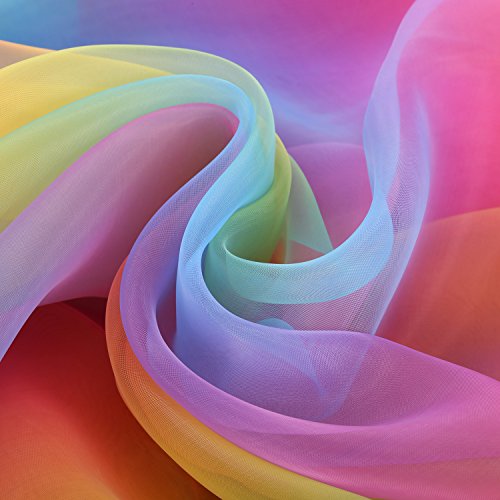 Can you quit with a lightweight material such as voile? The answer is yes and no. Voile has a satiny feel to it and veil-like transparency. Traditionally made from cotton, you often find it either made from 100% polyester or containing a polycotton blend these days.
Can you quit with a lightweight material such as voile? The answer is yes and no. Voile has a satiny feel to it and veil-like transparency. Traditionally made from cotton, you often find it either made from 100% polyester or containing a polycotton blend these days.
Though quilting with voile presents some challenges, this semi-sheer material creates much lighter, cooler quilts than quilter’s weight cotton. Quilts meant to hang for artistic purposes or summertime quilts often use this light material.
Of course, sewing on slippery voile presents some challenges perhaps best left in the hands of experienced quilters! You will need to use silk pins and a finer needle on your sewing machine. Plus, voile usually costs quite a bit more than quilting cotton.
That said, voile has a few advantages, too! It shrinks less than quilting cotton in the wash. You can also counteract the difficulty of piecing together slippery scraps of voile by using a little spray starch.
4. Cotton Flannel
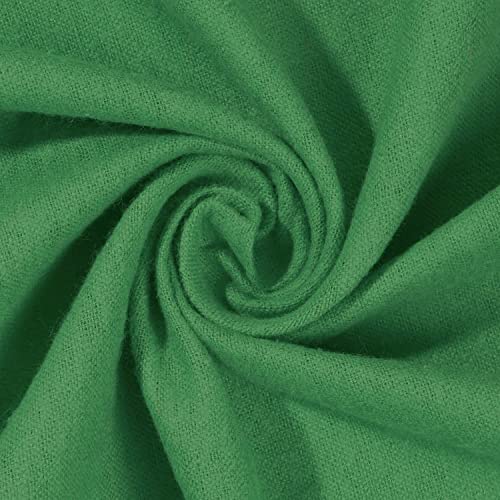 Cotton flannel quilts make an adorable, heartfelt gift to welcome a new baby! Of course, you can make flannel quilts for other occasions as well, but a stroll down the baby-print loaded flannel aisle at any sewing store will quickly show you how popular this extra-soft version of cotton is for baby blankets.
Cotton flannel has a soft nap made by scraping metal bristles over the woven fabric during its production. This lifts out thousands of tiny cotton fibers, creating that lovely, velvety surface! You will want to make sure you purchase actual 100% cotton flannel by reading the end of the bolt or the product description because some flannel contains polyester these days.
Cotton flannel quilts make an adorable, heartfelt gift to welcome a new baby! Of course, you can make flannel quilts for other occasions as well, but a stroll down the baby-print loaded flannel aisle at any sewing store will quickly show you how popular this extra-soft version of cotton is for baby blankets.
Cotton flannel has a soft nap made by scraping metal bristles over the woven fabric during its production. This lifts out thousands of tiny cotton fibers, creating that lovely, velvety surface! You will want to make sure you purchase actual 100% cotton flannel by reading the end of the bolt or the product description because some flannel contains polyester these days.
Polyester costs less than cotton, but if you’re making a baby gift, you probably want to use 100% cotton or even organic cotton flannel. On top of this, flannel can also have a higher and lower thread count that impacts its quality. If you hold up a scrap of the material to the light and you can see a loose weave through the flannel fuzz, you probably have low-quality material!
Quilting with flannel does present a few unique challenges. First, cutting it out neatly, especially if the material has a plaid or striped pattern, may give you a headache. You should try a little spray starch to keep the material straight while you cut!
Second, flannel frays all over the place. You can use pinking shears to keep the fraying at bay while you sew, but you will need to finish all your seams by using a serger or a zigzag stitch wherever possible for long-term protection.
5. Wool
 If you want a truly insulating quilt, consider quilting with wool! Wool fibers have a unique crimped quality that helps them hold in pockets of warm air.
Wool offers all-natural protection from mold and mildew and is also flame-resistant! Plus, this quite amazing material lasts a long time with the proper care.
If you want a truly insulating quilt, consider quilting with wool! Wool fibers have a unique crimped quality that helps them hold in pockets of warm air.
Wool offers all-natural protection from mold and mildew and is also flame-resistant! Plus, this quite amazing material lasts a long time with the proper care.
Wool also does not fray when you cut it! This makes cutting out all the shapes for your quilt blocks a breeze.
On the downside, 100% all-natural wool costs a lot. It also has more bulk than the quilter’s cotton, so you will need to use strong thread, a heftier needle, and possibly a walking foot on your machine. You will have to press seams open inside the quilt to avoid creating big ridges at every intersection, too!
You also will not find the vast array of printed patterns you can get with quilting cotton if you go with wool. That said, wool quilts may last for decades and they offer a really practical choice if you live in a cold climate.
6. Quilter’s Weight Linen
 You can find linen in various weights, including a thicker, denser version termed quilters weight linen. Linen, an all-natural material made from flax fibers, usually has a nubby loose weave that looks homespun and feels amazingly soft.
You can find linen in various weights, including a thicker, denser version termed quilters weight linen. Linen, an all-natural material made from flax fibers, usually has a nubby loose weave that looks homespun and feels amazingly soft.
Flax fibers have hollow pores, which means that a linen quilt will provide amazing insulation, too!
Some experienced quilters warn against using linen for quilting because it shrinks easily and its looser weave can cause pieces to shift around as you sew.
That said, you can use linen if you make a few adjustments. First, you shouldn’t mix lineman and cotton in a quilt. This is just asking for trouble as the fabrics shrink at different rates.
Second, linen unravels fast as you cut it. You will need spray starch to help you cut out all the pieces.
Finally, you will need to use small stitches, a slightly larger seam allowance, and finished edges if you want to work with linen.
7. Novelty Materials
Here’s the thing: you can make a quilt out of just about any material, including old t-shirts, pieces of your wedding dress, or bits of your child’s baby clothes! This quilting creates a precious keepsake, but piecing together these materials won’t necessarily make the most durable quilt.
For the easiest quilting experience and the most usable quilt, you are best off working with quilting cotton. That said, making a quilt has been a way to stitch memories and share experiences for hundreds or even thousands of years, so go ahead and make that t-shirt quilt!
If you want to use stretchy or fragile material, you can try applying fusible interfacing to the back of the fabric before cutting it out. As a pro tip, you will probably find this kind of quilting easier if you just cut out blocks of each “memory” fabric instead of trying to piece together an elaborate design for each quilt block.
What Is Double-Faced Quilted Fabric?
 Double-faced quilted fabric is actually two pieces of fabric sandwiching a thin layer of batting, all held together by diamond-shaped stitching patterns. You can think of this as “pre-quilted” material.
Double-faced quilted fabric is actually two pieces of fabric sandwiching a thin layer of batting, all held together by diamond-shaped stitching patterns. You can think of this as “pre-quilted” material.
You do not want this kind of material for your quilting projects, but it does come in handy if you want to sew a warm jacket. You can also make pillows, simple blankets, and many other projects out of this padded material.
Quilted fabric can contain many different kinds of material, such as plain weave cotton, polyester, or cotton or polyester broadcloth.
What Is Pre Quilted Fabric?
 Pre-quilted fabric is just another name for the double-faced fabric. It describes two pieces of fabric sewn on either side of a thin layer of batting. Batting is a thin sheet of pillow stuffing and can contain either cotton or polyester fibers.
Pre-quilted fabric is just another name for the double-faced fabric. It describes two pieces of fabric sewn on either side of a thin layer of batting. Batting is a thin sheet of pillow stuffing and can contain either cotton or polyester fibers.
This is not a material you will want to use if you plan to cut out and piece together quilting blocks. That said, you can use one big piece of pre-quilted material and simply sew on a binding edge to make a quick, cute blanket!
While this may not exactly fall into the category of “quilting,” it still makes a nice end product. If you need a gift in a hurry, you should buy pre-quilted fabric!
How to Choose Fabric for a Quilt
Selecting exactly the right fabric for your quilt matters a lot because you will spend many hours cutting out, piecing together, and sewing this complex project! After putting all that wok in, you do not want to experience the tragedy of seeing your quilt unravel in the wash.
So, consider these quick tips as you make your selection:
- Don’t mix and match different kinds of fabric in your quilt blocks. You can, of course, mix many different prints and colors in your design, but use all quilting cotton or all voile, etc. Mixing fabric types can cause strain on the seams and end up unraveling or stretching portions of the quilt.
- Unless you’re making a t-shirt quilt, avoid using knit fabric. This type of material has too much natural stretch to create precise shapes while sewing.
- Likewise, use thread made of the same material as your fabric almost all of the time. The one exception to this rule is that you may want to use strong silk thread if you quilt with wool.
- Do pre-wash your material. This should prevent shrinking or even tearing when you go to wash the finished quilt.
- It’s tempting to buy cost-effective synthetic materials like polyester, but these plastic-based products don’t handle high heat well, and quilting often requires a lot of ironing. Plus, people with sensitive skin may not want a quilt made from synthetic material. If you plan to spend twenty hours or so crafting a quilt, you should probably splurge on good all-natural fabric to make the best product possible!
- Along those lines, if you can afford premium-quality quilting cotton, you should shell out for it! Ultimately, fabric with a denser weave and higher thread count will last longer and look nicer than cheaper material.
What Is the Difference Between Cotton and Quilting Cotton?
 Quilting cotton has a denser weave and a heavier weight than apparel cotton. Quilter’s weight cotton should also have a high thread count, ideally over 68 threads per square inch. This stiff, durable material cuts easily and allows for easy piecing together as you sew.
Quilting cotton has a denser weave and a heavier weight than apparel cotton. Quilter’s weight cotton should also have a high thread count, ideally over 68 threads per square inch. This stiff, durable material cuts easily and allows for easy piecing together as you sew.
Regular and quilting cotton contain 100% cotton thread, so don’t go by that when you select your quilting fabric! Instead, look for a thicker, stiffer material that doesn’t drape loosely.
The good news is that quilting cotton often costs less than apparel cotton because it is sold in a 45” width instead of a 55” inch width like most apparel fabrics. It also comes in a huge range of prints, patterns, and colors.
What is Premium Quilting Fabric?
Premium quilting fabric is 100% cotton quilting fabric that has a high thread count and uses a more complex dying process. This type of quilting material costs more and often comes from specialized brands rather than big chain stores.
Premium fabrics often start with higher-quality cotton staples and use cotton threads that have a finer diameter. This, combined with the higher thread count, makes for a silkier finished product with the necessary dense weave for durability.
On top of this, many premium quilting materials feature flat-bed press printing instead of the less complex high-speed rotary press used by cheaper fabrics. This allows for detailed engravings and more layered colors in the design.
If you can afford it, premium quilting fabric does make beautiful, durable quilts.
What Fabric is Best for Quilt Backing?
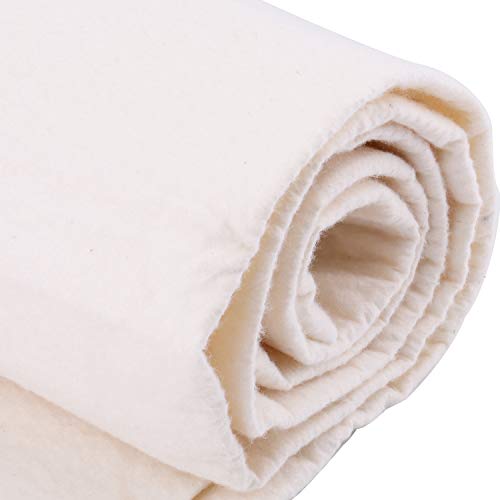 Most of the time you will want to use the same material for the front and backing of your quilt. That said, quilting cotton offers a strong, durable material for quilt backing and is the most popular choice for quilt backing.
Most of the time you will want to use the same material for the front and backing of your quilt. That said, quilting cotton offers a strong, durable material for quilt backing and is the most popular choice for quilt backing.
As you probably know, a quilt backing forms the bottom layer of the quilt, resting beneath the quilt face and the batting.
You can buy extra-large pieces of fabric specially for quilt backings. You will sometimes see this material called “wideback” fabric. It comes in a 108” width!
Alternatively, you can easily piece together large chunks of quilting cotton to make your own backing.
You should always cut your backing three to four inches larger than the planned size of the quilt face. This allows room for shrinkage or shifting as your piece together the quilt blocks.
Where Can You Buy Quilting Fabric?
You can buy quilting fabric at sewing stores, online craft sellers like Etsy, and specialized brands like Robert Kaufman. On top of this, you can find many online stores specializing in selling quilting fabric, such as the fat quarter shop or even fabric.com.
Buying from a reputable brand like Robert Kaufman lets you know for sure you’re purchasing premium quilting fabric. Of course, this option typically costs more!
Buying from a box store allows you the fun of wandering the aisles and comparing all the pretty prints, which can also be part of the fun! Typically, large sewing stores will sell basic quilting cotton and not premium-quality fabric, though.
If you want a truly personalized quilt, buying unique designs or even hand-dyed material off Etsy might appeal to you. You will need to do a little research to make sure you get fabric with a high thread count and the proper weight if you buy from an online seller.
Buying from an expensive brand or your nearby craft store each has its own pros and cons. The bottom line is that you should make a quilt that suits your taste. Yes, you will find quilter’s cotton easier to work with than any other material. But if you want to make a flannel quilt, a wool quilt, or a t-shirt quilt, go for it!
Conclusion
Quilter’s weight cotton is the most popular choice for quilting fabric because it has a thicker, durable weave that allows for easy cutting and sewing. Cotton with a high thread count will feel softer and last longer than cheaper quilting cotton. That said, lightweight cotton voile or fuzzy cotton flannel can also make lovely quilts if you want a softer or silkier quilt for special circumstances.
Another popular type of quilting uses keepsake fabric like pieces of a t-shirt to create a memory quilt. Using this material presents some sewing challenges but offers a thoughtful way to memorialize a person or a piece of family history.
Have you ever made a quilt? What type of material did you use? Leave a comment below to let us know!